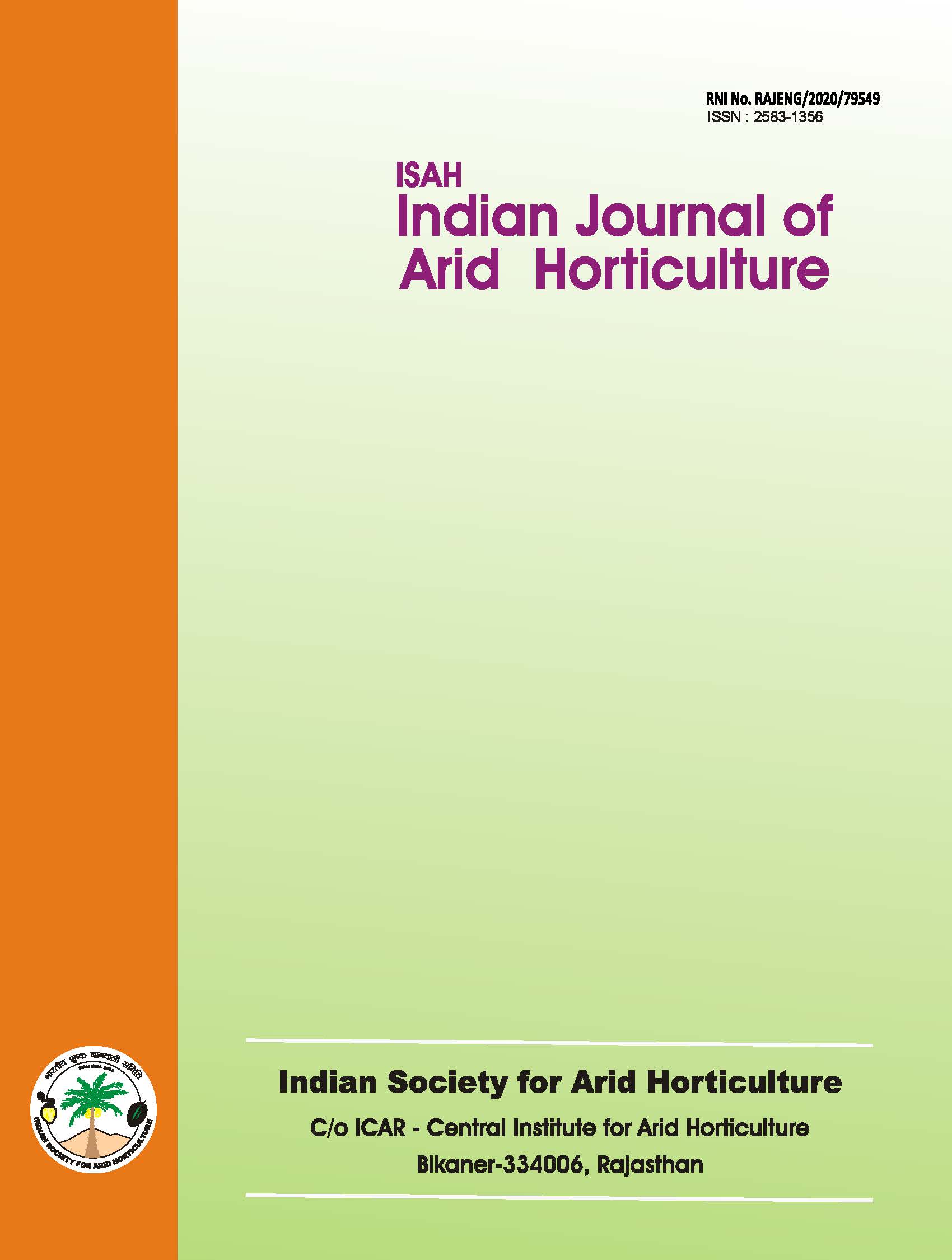Studies on the effect of times of patch budding in Aonla
Keywords:
Aonla, patch budding, time of propagationAbstract
The present experiment was carried out at Fruit Research Station, Kuthulia, College of Agriculture, Rewa (M.P.) st st th st during 2008-09. The investigation was carried out on ten treatments i.e., 21 September, 01 October, 11 October, 21 st th st st th st October, 01 November, 11 November, 21 November, 01 April, 11 April and 21 April in a randomized block design with four replications. The results showed that the maximum bud sprouting percentage (69.25 %), survival percentage (64.50 %), bud take success percentage (58.75 %), leaf chlorophyll content (5.65), shoot length, shoot diameter and st number of leaves per sprouted shoot were recorded in the month of 21 April. However, maximum time taken for bud st sprouting (30.75 days) was found in 21 November. Whereas, minimum bud sprouting percentage (24.75 %), survival percentage (22.50 %), bud take success percentage (14.25 %), shoot length, shoot diameter and number of leaves per st sprouted shoot were recorded in the month of 21 November. However, minimum time taken for bud sprouting was found st st st in 21 April and leaf chlorophyll content (3.04) in 1 November. The results reveal that date of budding 21 April was significant superior to all other date of budding. However shoot length per sprout at 90 days after operation, shoot diameter per sprout at 15, 45, 60 and 90 days after operation and number of leaves sprouted shoot at 60, 75 and 90 days after operation th st were non- significant. The patch budding given best suitable period obtained from the month 11 April to 21 April.
Downloads
References
Kour, Ravneet and Singh, Sarabjeet. 2009. Shoot 10 (2): 314-315.
development pattern as affected by method and time of Shrivastava, A. L., Singh, H. K. and Singh, I. S. 2002. Studies
budding in aonla (Emblica officinalis Gaertn). Asian J. on propagation of aonla (Emblica officinalis).
Hort., 4 (1): 204-205. Haryana J. Hort. Sci., 31 (4): 156-158.
Kumar, Anuj, Bhatia S. K. and Joon M. S. 2004. Singh, B. K., Sharma, S. Ram Niwas and Kumar, S. 2003.
Standardization of in-situ patch budding time in aonla Effect of method and time of budding on bud sprouting
(Emblica officinalis). Haryana J. Hort. Sci., 83 (4): in aonla. Haryana J. Hort. Sci., 32 (2): 27-28.
234-235. Singh, G. K. and Parmar, A. S. 1998. Studies on the effect of
Negi, R. S., Baghel, B. S., Gupta, A. K. and Singh, Y. K. 2010. methods and dates of budding in aonla (Emblica
Standardization of method of orchard establishment officinalis). Annals of Arid Zone, 37 (2): 199-201.
and propagation in aonla (Emblica officinalis Gaertn) Upadhyay, N. P. and Prasad, R. S. 1988. Effect of time on patch
for rehabilitation of degraded pasture/ grazing lands. budding on sprouting and growth in aonla. Indian J.
Annals of Hort., 3 (1): 39-46. Hort., 45 (1&2): 61-62.
Pathak, R. K., Ojha C. M., Dwivedi R. and Hari O. M. 1991. Wagh, A. P., Choudhary, M. H., Jadhao, B. J., Damke, M. M.
Studies on the effect of method and duration of and Joshi, P. S. 2001. Studies on propagation in aonla.
budding in aonla. Indian J. Hort., 48 (3): 207-212. J. Soils and Crops, 11 (1): 74-77.

